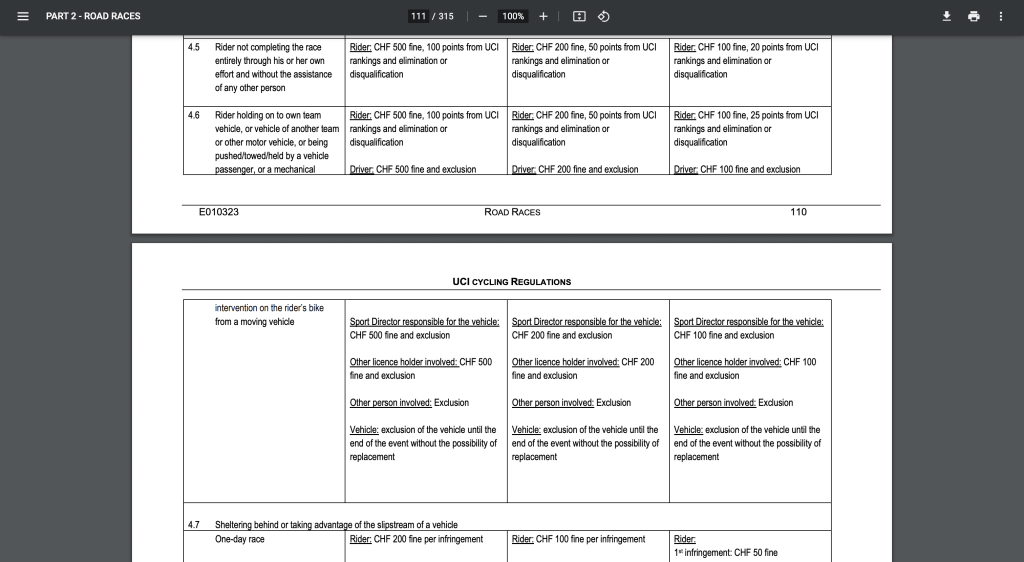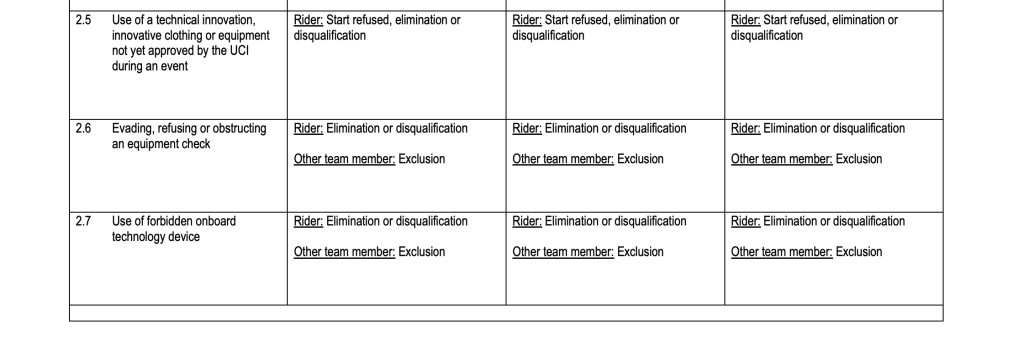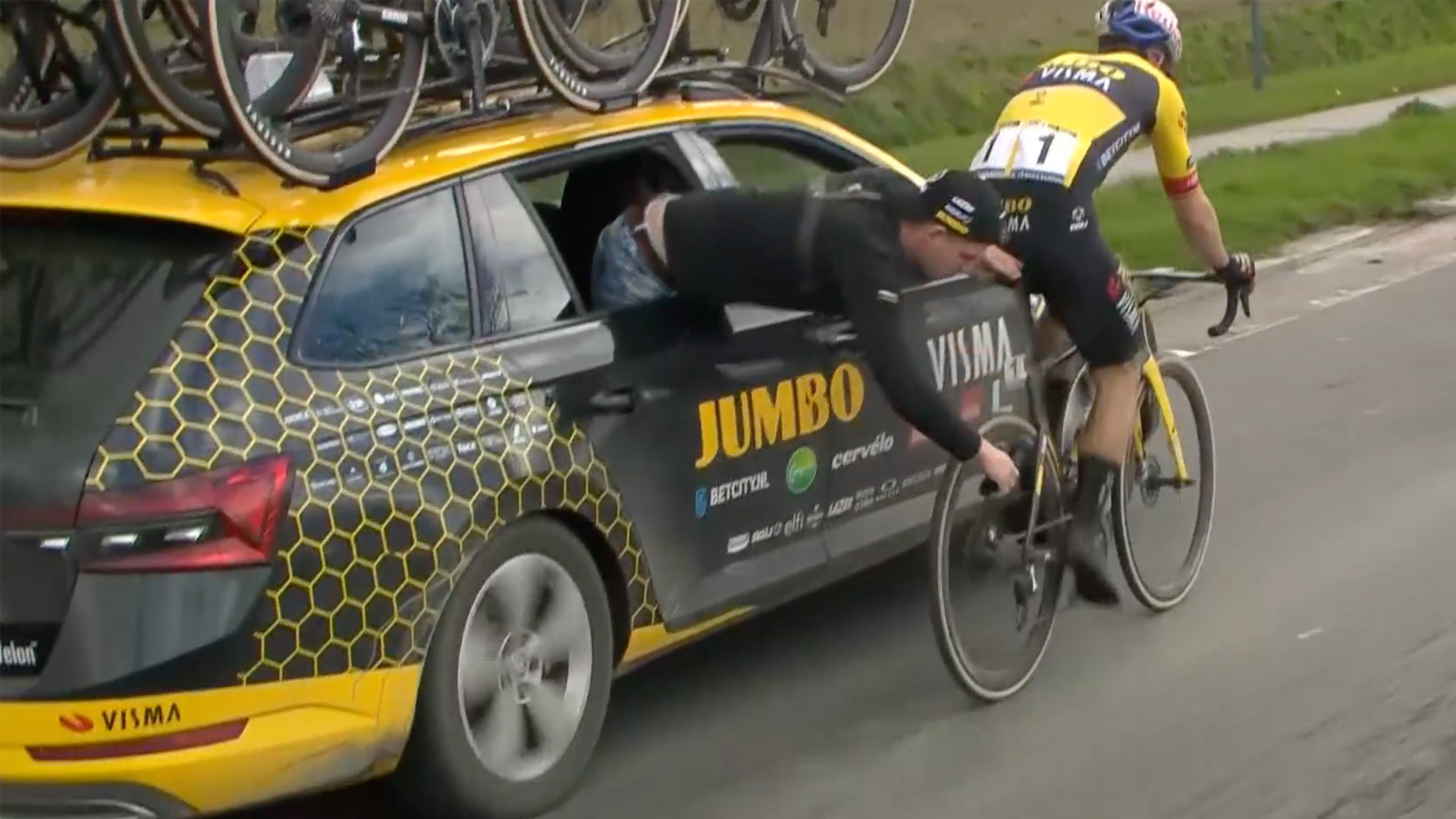Wout van Aert claimed his second consecutive E3 Saxo Classic victory on Friday past. His sprint win against Mathieu van der Poel in “the mini Ronde” confirmed van Aert is amongst the favourites for this weekend’s big Ronde.
An innocuous moment, similar to those seen dozens of times every season, now has some calling for the winner’s disqualification. The UCI jury at E3 decided against this frankly insane action, thankfully, but did so in breach of its own rulebook.
A rulebook isn’t worth much when bits of it are ignored because they’re ridiculous. So how did we end up here?
What happened
The mechanic in the Jumbo-Visma support car leaned out the window and lubricated Van Aert’s chain. For renowned commentators Rob Hatch and Adam Blythe and rule book geeks such as myself alike, the incident went … almost unnoticed. The roads were wet, the riders had just come off the Varant cobble section, and van Aert’s chain was presumably squealing for some TLC.
TV camera motorbikes directly in front and behind the three-person van Aert group, the commissaries car pulls out of the way to let the Jumbo-Visma car through to service its rider. The mechanic leans out the window, breaks the rules, the chain is happy and all is normal. We’ve seen it a hundred times before.
What does the rule say?
The problem, though, is those calling for Van Aert’s disqualification were right. UCI regulation 2.3.030s clearly states, “the greasing of chains from a moving vehicle shall be forbidden.”

Understandably, the regulation adds a little commissaire discretion specifically in the case of a rider working his/her way back from a crash: “In case of a fall, the implementation of this disposal is left to commissaire’s discretion.” But Van Aert hadn’t suffered a fall, he was at the head of the race and dropped back to his support vehicle for assistance.
It’s a clear-cut rule violation, the penalty for which is equally clear-cut – CHF 500 fine, 100 points from UCI rankings and elimination or disqualification for the rider along with a fine and exclusion for the driver, sports director and other persons involved as laid out in table 2.12.007 article 4, Irregular assistance, repairs or feeding, section 4.6.

All in the wording
Regulation 2.3.030 is as fine an example of the UCI tying itself in knots as you are likely to find.
Whatever the position of a rider in the race, he may receive such assistance and
mechanical check (brakes for example) only to the rear of his bunch and when stationary.
The greasing of chains from a moving vehicle shall be forbidden.
In case of a fall, the implementation of this disposal is left to commissaire’s discretion.
Let’s break it down.
“Only to the rear of his bunch and when stationary”
Granted I am being pedantic, but how is the rule applied for solo riders and how does a rider be at the “rear of his bunch” and “stationary?” Does the stationary infer actually stopped at the side of the road, as I presume it to mean, or does it mean freewheeling with the pedals stationary but the bike still moving? Or should it just simply read “rear of his bunch OR when stationary?”
“The greasing of chains“
Who applies grease to a chain? Nobody, that’s who. Perhaps Van Aert avoided the commissaires wrath because the Jumbo mechanic didn’t grease the chain as outlawed by the regulations but instead used Dynamic Bike Care’s Speed Potion drip wax on his chain? Yes, again, I am being pedantic, but this is overly explicit wording in what is usually an intentionally vague rulebook.
It’s pedantic nitpicking, but it’s exactly how I imagine anyone would pick apart the rule if a World Tour podium place was on the line.
To be fair, the wording is a simple translation from the French version of the regulations the UCI says take precedence. The French says, “Le graissage de chaînes,” which does literally translate to “grease the chain” but is more like lubricate.
How long can a poorly written rule sit in the regulations unedited and unimplemented? This one was intentionally updated in 2011. At some point, such rules blow up into the sort of storm in a teacup that developed in the closing stages of E3. A storm that is not anyone’s cup of tea.
Why doesn’t the rule simply states: “mechanical assistance from a moving vehicle is strictly prohibited”? No ambiguity, no grey area, no confusion.
Lastly, there is the caveat that all of the above may be ignored if the mechanic is administering the magic spanner treatment following a crash. But this writer is ok with that.
What say the UCI
The UCI did not respond to our request for comment on article 2.3.030 of the regulations. Quelle surprise.
However, Sporza.be is reporting the UCI commissaire at the race decided no further action was required because van Aert received no advantage, received the service at the back of the group, and didn’t even hang on to the car. While the footage isn’t entirely conclusive on the point of touching the car, he certainly receives a push from the mechanic.
Furthermore, Van Aert is clearly seen chucking a gel wrapper a split second before the mechanic gets to work, but there is no mention of the apparent infringement on article 2.2.025, “riders may not jettison food, bonk-bags, feeding bottles, clothes, etc. outside of the litter zones provided by the organiser.”
Cyclingnews.com reported Jumbo-Visma’s DS on the day, Arthur Van Dongen, agreed the act was technically in breach of the regulations but also explained he sees it “100 times a year” and offers no advantage. Van Dongen reportedly added the rules “should not be black and white, instead retaining some degree of subjectivity.”
Ok, was there an advantage?
As for an advantage, it’s difficult to be certain. Darran Moody of GLF Chain Wax told us a dirty chain versus a clean and oiled chain could be as much as a 5% loss. But as skilled as the Jumbo mechanic was at oiling the chain out the car window, he didn’t clean the chain as well. Practice makes perfect I guess.
A dirty but oiled chain almost certainly performs better than a dirty dry chain, but how much better and whether the gains are linear from cruising speed right the way through to a full gas sprint effort is anyone’s guess. My guess: I’d much prefer a dirty but oiled chain to a dirty and dry one.
Another brand told us they can see up to 9 watts of extra drag in a dirty chain in wet conditions. Our guess is that Van Aert was simply sick of listening to the chain rattling and squealing and wanted to silence it. Pog and Van Der Poel likely didn’t enjoy listening to it either.
Jumbo-Visma’s lubricant sponsor, Dynamic Bike Care, has since explained on social media that Van Aert had experienced shifting issues and the lube was applied in a last-ditch attempt to fix the issue.
Why it matters
Van Dongen calls for subjectivity to prevail, but herein lies the problem. At least by the UCI’s standards, this rule is as black and white as they come. Rightly or wrongly, “the greasing of chains from a moving vehicle shall be forbidden.”
Clearly, this section of the rule does not allow for nuance or discretion. Have your mechanic lube your chain … you will be disqualified.
The UCI writes lots of rules so that punishments are at the total discretion of the commissaires. This is not one of them.
Similarly, as Kristen Faulkner found out last week, article 1.3.006bis clearly states “devices which capture other physiological data, including any metabolic values such as but not limited to glucose or lactate are not authorised in competition,” the penalty for which is seemingly covered under section 2.5 or 2.7 of the same table and is listed as elimination or disqualification. Presumably, Faulkner might now question why the rules are applied so strictly to one World Tour podium but not to another.

I can’t think of anyone who believes van Aert should have lost his E3 title for such an act, and we are in no way advocating that he should. But what now for this rule? Will the UCI abrogate or reword the rule? If not, shall it be enforced going forward? If it is enforced in the future, can riders and teams appeal any fines and disqualifications based on Van Aert’s case? If so, surely the rule be abrogated? It’s all a mess.
Van Dongen, the commissaires, the UCI, heck, even myself might all agree the rules sometimes cannot be black and white, or at least are very difficult to write in a clear-cut manner applicable to all scenarios in the highly complex and ever-changing sporting environment that professional road racing takes place in.
If the UCI wants to be as specific as banning greasing chains from a moving vehicle, it must be ready to implement the rule whenever and wherever it is broken. Or it should remove the rule. It has the power to do so.
The F1 Saudi Arabian GP in Jeddah last weekend is a clear example of why this is important. Long story short, Fernando Alonso was handed a ten-second penalty for improperly serving a 5-second penalty. Alonso’s rear jack mechanic had touched the car with his jack before the 5-seconds had been served. The rules state no work can be done on the car before the 5-seconds is served but makes an allowance for the front jack mechanic to touch the car with a jack. Alonso’s team effectively argued a jack is a jack regardless if it’s front or rear, and provided seven examples of instances the FIA had not penalised other teams for the same offence. Alonso’s ten-second penalty was rescinded, but only after he had first been on the podium, had his third place awarded to George Russell, only to later be reinstated to third place.
It was a ridiculous scenario, caused by failing to clarify a rule that was regularly broken but ignored. The UCI will surely face a similar issue should a commissaire ever penalise a rider for greasing their chain on the go.
Did we do a good job with this story?

